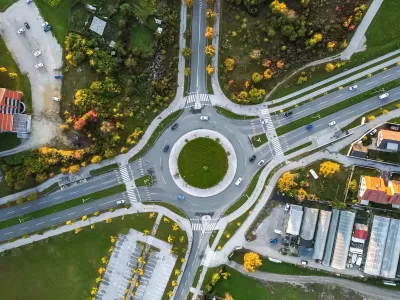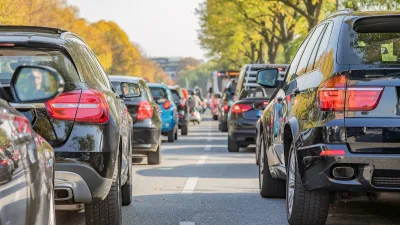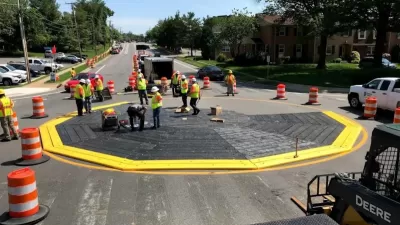What drives the U.S. backlash to roundabouts — objectively safer and more efficient than stop-and-go intersections?

Ah, the roundabout. A common sight in many global regions and a fearsome adversary for many American drivers.
But as the movement to install roundabouts and traffic circles — a type of intersection designed to keep traffic flowing, often without stoplights — John Surico wonders whether U.S. drivers can finally embrace the (incredibly efficient!) model. As Surico notes, “Nationwide, the US now has more than 10,000 roundabouts, a figure that’s doubled in a decade.”
In some U.S. communities where roundabouts have been installed, the backlash has been fierce. Yet “By just about all measures, the modern style of roundabout — where cars are meant to seamlessly yield in a circular pattern — are an easy win: They save lives, reduce traffic delays and cut emissions.”
Surico attributes the vitriolic opposition to roundabouts in part to a lack of familiarity and an image of roundabouts as only monstrous, multi-lane traffic circles. Cities that install more roundabouts at once tend to have more success as drivers learn to navigate them and become accustomed to them. In Carmel, Indiana, a bold experiment led by then-mayor Jim Brainard installed over 150 roundabouts across the city. Early opposition turned to strong support when residents began to notice the congestion relief and cost savings. The former mayor credits public outreach and education, which included informational TV spots and neighborhood meetings, with encouraging residents to understand and appreciate the benefits of roundabouts.
FULL STORY: Can American Drivers Learn to Love Roundabouts?

Planetizen Federal Action Tracker
A weekly monitor of how Trump’s orders and actions are impacting planners and planning in America.

Maui's Vacation Rental Debate Turns Ugly
Verbal attacks, misinformation campaigns and fistfights plague a high-stakes debate to convert thousands of vacation rentals into long-term housing.

San Francisco Suspends Traffic Calming Amidst Record Deaths
Citing “a challenging fiscal landscape,” the city will cease the program on the heels of 42 traffic deaths, including 24 pedestrians.

Amtrak Rolls Out New Orleans to Alabama “Mardi Gras” Train
The new service will operate morning and evening departures between Mobile and New Orleans.

The Subversive Car-Free Guide to Trump's Great American Road Trip
Car-free ways to access Chicagoland’s best tourist attractions.

San Antonio and Austin are Fusing Into one Massive Megaregion
The region spanning the two central Texas cities is growing fast, posing challenges for local infrastructure and water supplies.
Urban Design for Planners 1: Software Tools
This six-course series explores essential urban design concepts using open source software and equips planners with the tools they need to participate fully in the urban design process.
Planning for Universal Design
Learn the tools for implementing Universal Design in planning regulations.
Heyer Gruel & Associates PA
JM Goldson LLC
Custer County Colorado
City of Camden Redevelopment Agency
City of Astoria
Transportation Research & Education Center (TREC) at Portland State University
Jefferson Parish Government
Camden Redevelopment Agency
City of Claremont





























